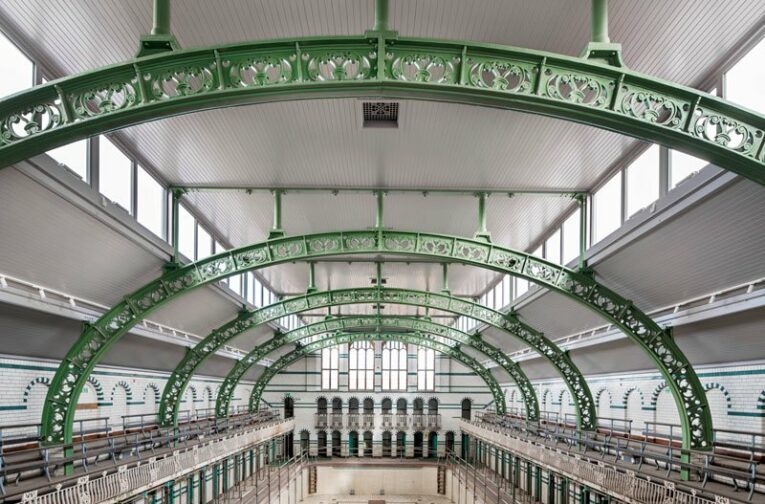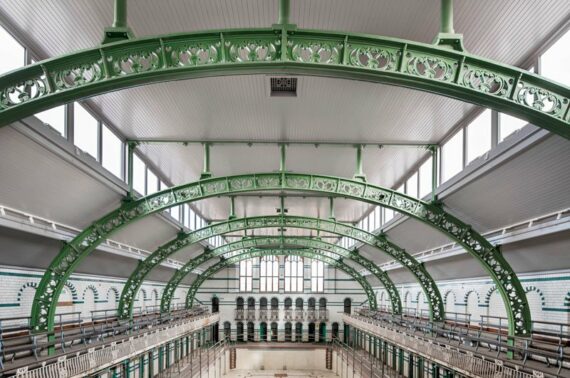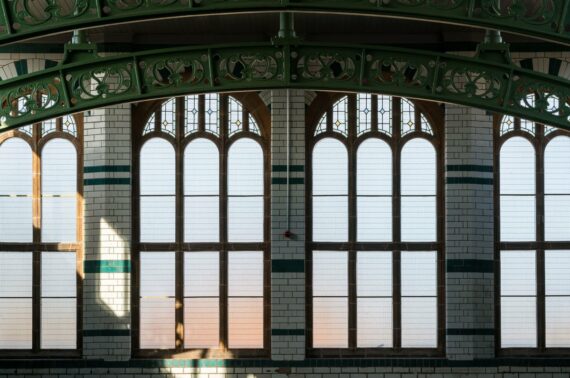Moseley Road Baths Conservation: Case Study
- | Matthew Vaughan
Matthew Vaughan, Associate Director of our Birmingham office on the restoration and conservation of Moseley Road Baths, Birmingham. This article was originally published in the Victorian Society’s magazine ‘The Victorian’.
The exuberant, exotic façade of Moseley Road Baths stands like a fortress in Balsall Heath – an area dotted with richly decorated buildings from the same era, amid a background of bustling businesses run by families of heritage from seemingly every nation. When I moved to Birmingham just over ten years ago, I lived in a parallel street, and it was one of the buildings that inspired me to adopt the city as a home. It is one of the hidden gems that tourists rarely see, in a place where it takes some time to get below its skin – and one where it seems everyone born in the area learned to swim.
Part of a Grade II* complex including the Free Library (opened 1895, designed by Jethro A. Cossins and Peacock), the Baths were opened in 1907, and designed by William Hale and Son.
The interior is as lavish as its exterior, with mahogany counters, terrazzo flooring, stained glass lanterns and glazed bricks – a palace of ‘wellness’ as we might call it today, for the residents of this historic borough, built it is said to encourage voters to join the city of Birmingham.
By 2016, the building was threatened with closure, due to the expense of maintaining it in use as a municipal leisure centre. However that year a ‘coalition of the willing’ came together, led by the National Trust, to work alongside Birmingham City Council (BCC) – who owns the building – to reimagine a new future for the Baths with swimming at its heart. The coalition also includes the Friends of Moseley Road Baths, the Moseley Road Baths CIO – an incredibly dedicated group of volunteers who operate swimming on a day to day basis – Historic England (HE) and the World Monuments Fund.
The building is at a ‘tipping point’ in its history, where substantial capital investment is needed, but a sound business is still deliverable if this funding can be obtained. The Gala Pool is the most significant space in the complex which includes Pool Two (still in use for swimming).
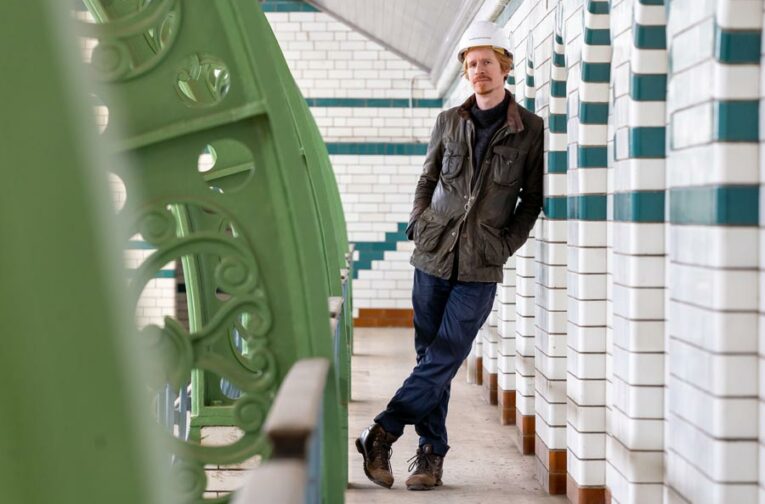
Conservation programme
The goal of this project, funded by grants of £715k by HE and £100k by BCC, was to bring the space back into public use, although not in the short-term for swimming – while the grant was generous, this was a programme of targeted repair. Further repair work includes to the flat roofs, concrete balconies, upgrading of pool plant equipment, ventilation and the pool itself.
An initial problem was the presence of guano which needed to be removed under controlled conditions – this was carried out (by Midland Conservation) while the main works were developed, accelerating the programme and reducing risk. Fortunately the condition of the steel and iron frame was better than previous surveys had suggested – a great deal of corrosion had taken place however, because of chlorine in the pool atmosphere. The frame was strengthened using minimal intervention according to Mann Williams’ design. A major cost though was associated with the bases of the trusses, built into glazed brick walls which needed to be broken out; rather than replace these bricks, tile slips were used which were identical in appearance, but lower in cost.
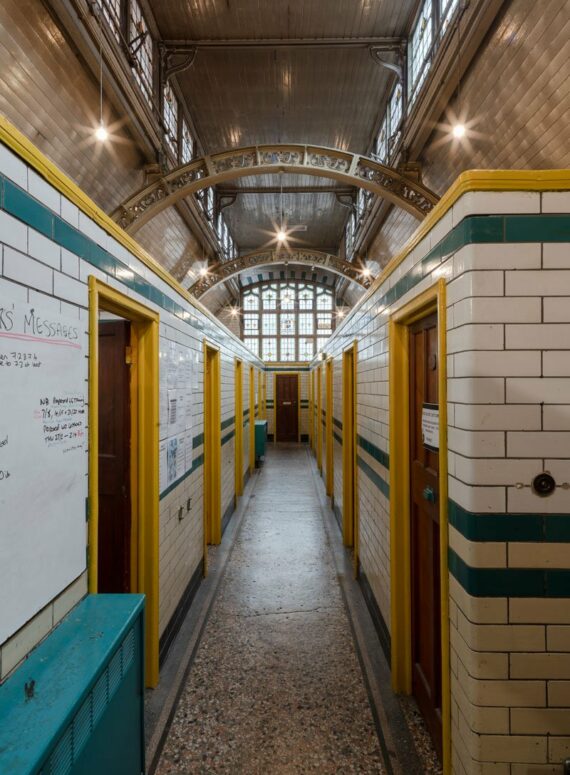
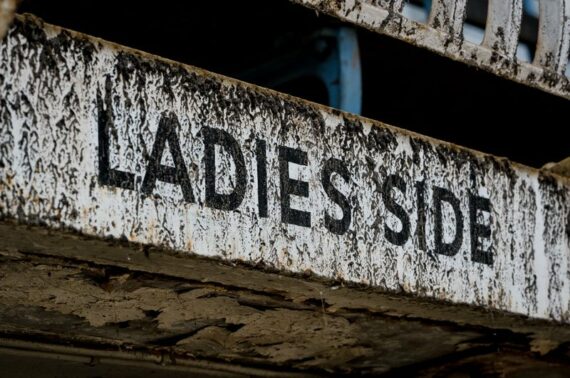
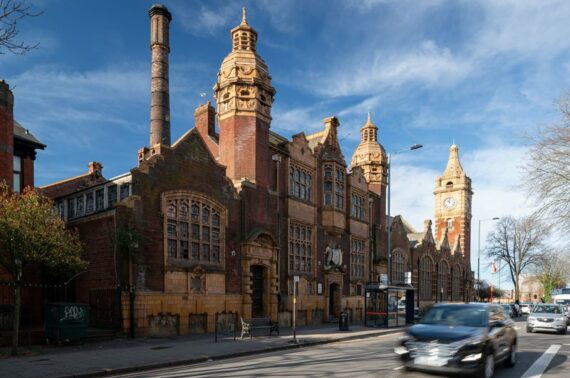
Other substantial costs were painting the frame – requiring surface preparation through shot blasting, and a two-part epoxy system applied by hand – and the scaffold. Terne-coated stainless steel was used for flashings due to risk of lead theft. Breathable wood-wool boards, were installed – the team produced a range of options, discussing with stakeholders the impact of say raising the roof finish (impact on historic roof zone), versus leaving the roof uninsulated. Smoke detectors and emergency lighting were critical to allow the space to be adapted for events along with ‘trace’ heating. The decorative programme began with historic analysis (by Chroma Conservation), but rather than reinstating the original brown varnish, a light grey was selected, partially to reduce the cost of lighting the space.
The opening was celebrated with ‘Specular Reflecular’ – an installation by Juneau Projects, who worked with over 500 local people to create a beautiful animation. This marked a major milestone in the rehabilitation of the Baths, bringing the Gala Pool into public use for the first time in seventeen years. As an architect living and working in Birmingham, and a member of the Victorian Society’s West Midlands Casework Subcommittee, this was an incredibly rewarding project to be involved in, but also made a delight by the gift of a project team of clients, consultants and contractor (Croft Building & Conservation) working closely and happily to achieve this impressive outcome; bringing an important and well-loved building back into use for the community to enjoy for years to come.
Subscribe to the Victorian Society's magazine